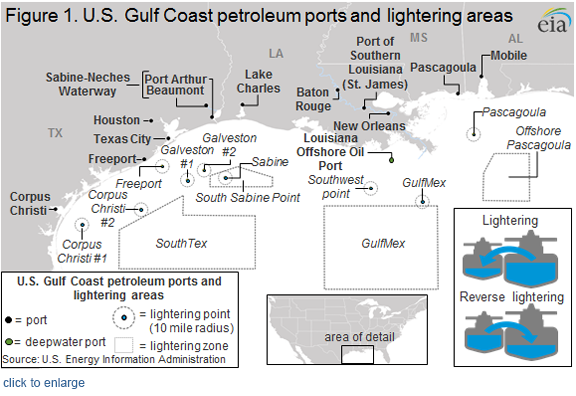US crude oil exports averaged 1.1 million barrels per day (b/d) in 2017, an increase of 527,000 b/d from 2016. Despite this acceleration in export growth, the US.Gulf Coast ports cannot fully load Very Large Crude Carriers (VLCC). Instead, export growth was achieved by using smaller and less cost-effective ships.
VLCCs need large ports with sufficient width and depth of waterways for safe navigation. All U.S. ports in the Gulf Coast that trade petroleum are located in inland harbors and connected to the open ocean via shipping channels or navigable rivers. However, these channels are not deep enough for the safe navigation of VLCCs.
[smlsubform prepend=”GET THE SAFETY4SEA IN YOUR INBOX!” showname=false emailtxt=”” emailholder=”Enter your email address” showsubmit=true submittxt=”Submit” jsthanks=false thankyou=”Thank you for subscribing to our mailing list”]
Currently, most U.S. Gulf Coast petroleum ports can accept vessels with capacities of approximately 500,000 barrels of crude oil, while the number of ports that can to accept vessels with capacities of approximately 900,000 to 1 million barrels are few. Thus, four AFRAMAX sized vessels or two SUEZMAX vessels are required to carry the same amount of crude oil as a single VLCC.
The inability to fully load larger and more cost-effective vessels has caused pricing implications for U.S. crude oil exports. Using a number of smaller ships requires a wider price spread between U.S. crude oil and international crude oil prices to balance the lower economies of scale and costs of reverse lightering and partial loadings.

The Louisiana Offshore Oil Port (LOOP), located offshore southern Louisiana in the Gulf of Mexico, is currently the only U.S. facility capable of accommodating a fully loaded VLCC. Nevertheless, trade press and company announcements have indicated that crude oil export projects with the intention to fully load VLCCs will be located near the port of Corpus Christi in southern Texas. Recently, it was announced that Corpus Christi will have a new terminal which will be able to accommodate VLCCs.


































































